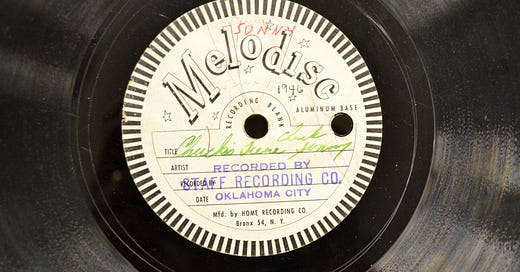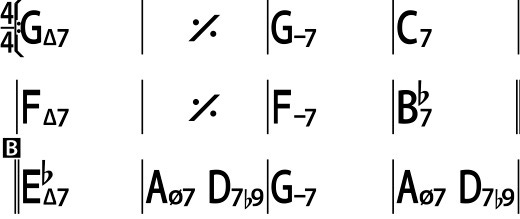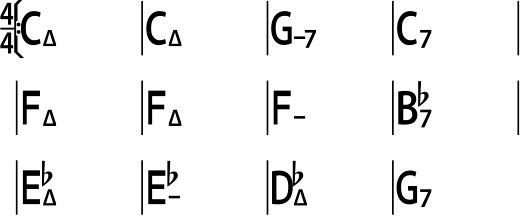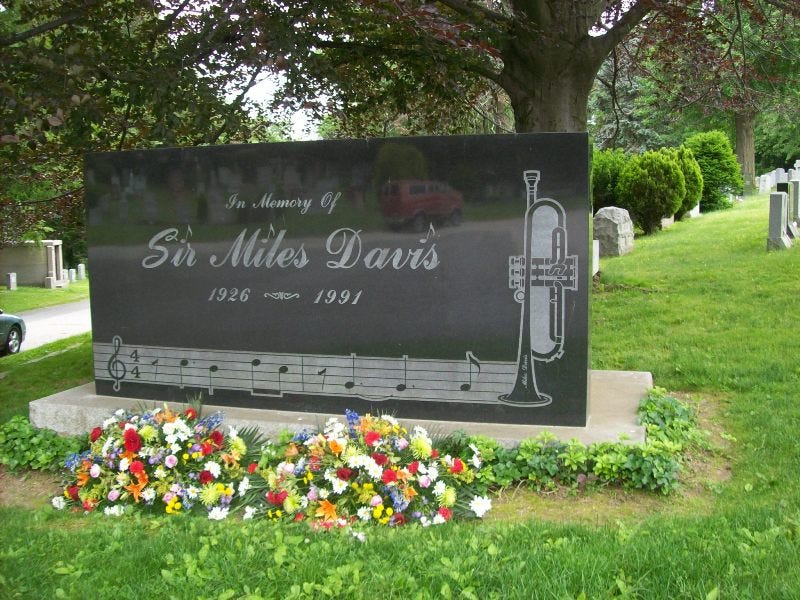How is “Solar” based on “How High the Moon”?
In the first post of this series, I gave some general information about why songs are sometimes credited to the wrong composer, and showed that when Miles is wrongly credited, one cannot assume that he “stole” the song. Then we started to explore “Solar.” That exploration continued in Part 2. Today we’ll finish our discussion of “Solar.”
In my experience, many people think that “Solar” is a blues. There are, I believe, two reasons that it’s hard for many to hear that “Solar” is based on “How High the Moon”:
For some reason, in jazz, when we say that one piece is “based on” another piece, that has come to mean only one thing: That both songs are based on the same chord progressions (the same “changes”). And “How High the Moon” is a 32-bar song in the form of ABAC. So, by that way of thinking, a 12-bar tune could not be based on it, period. However, the reality is that in music there are many, many ways that one song can be based on another one: You can use just the beginning of the melody and not the same chords, or use part of the chord progression and make a new melody, or use only the bridge, or only the rhythms, and so on.
When people see a 12-bar chord progression, they naturally try to fit it into some kind of 12-bar blues form. But not all blues are 12-bars, and—more important for this discussion—not all 12-bar chord sequences are blues. For an example of the latter, listen to the 12-measure A sections of “Conception” by George Shearing. Here is an electronic version, which is cheesy sounding but has the advantage of including sheet music. (Please do not leave comments saying that the piece is not by Shearing. I have proof that he wrote it, for another post.) There is no connection between any blues and the 12-bar A sections of “Conception.”
Also, I think it’s fair to say that a lot of what defines a blues song is that it has a “blues sound.” From the day I first heard “Solar,” it sounded to me like an abridged version of “How High The Moon,” because of the way each four-bar phrase was a whole step lower than the one before. It still doesn’t sound at all “bluesy” to me.
But the most important piece of evidence is the Chuck Wayne interview that I included in the previous post. Wayne himself said: “That was like the same changes as ‘How High the Moon’…in a sense it was based on the changes.” Reading a published interview is not as good as hearing the recording, but Cadence magazine has a policy of publishing interview transcripts complete and unedited (unlike Downbeat and other magazines). Besides, that’s not the kind of detail that an interviewer could have made up or misheard.
So, let’s take a look and a listen: “How High the Moon” is based on taking a melodic line and moving it down a whole-step, then down another whole-step. Here are the first 12 measures of the chords of “How High the Moon.” As you can see, it goes from G major down to F and down to Eb:
Notice that at the end of these 12 measures the D7b9 sets up a return to G. The next 4 bars, not included here, are a turnaround from G and back to D7 to get back to G again. So they therefore could be seen as expendable. And both halves of this 32-bar AB/AC form are the same, except for the last four (or in some versions five) bars. So apparently Wayne cleverly realized that the “meat” of the song is in the first 12 bars, and he decided to make a 12-bar tune using those chords. Let’s look at the first 12 measures of his “Sonny”:
As mentioned last time, Wayne’s disc as posted online plays in the key of Db, but I’ve moved it to C for ease of comparison. (Also I want to thank trombonist and violinist Dan Weinstein who took the trouble to listen to the chords and bass part on that old scratchy disc, and shared his notes with me.)
Look how close they are. The most significant differences are the first and last chord. Wayne realized that the notes of the G major triad that begins “How High”—G,B,D—are the upper notes of a C major 9th chord. By making the opening chord a C, somehow the form feels more self-contained, less like the first 12 measures of “How High.” But the derivation from “How High” still remains crystal clear, I think you’ll agree.
So what did Miles do to the chords? Because the song was being passed around among musicians, it could have been changed before it reached Miles. But he was always known to be an excellent arranger, particularly with respect to chords, so it’s likely that the new chords were his idea. Miles realized that the G major triad can also be the top notes of what we call a C minor-major chord—a C minor triad on the bottom, but with a major seventh. This gives a nice added mystery to the opening chord, so it doesn’t sound as drab—and it provides more energy and momentum.
Also, Miles completes the descending pattern in the third line, the last phrase. Instead of moving away from the Eb right away, he completes the move down yet one more whole-step to D-flat, before ending with the V of C, as Wayne did, to get us back to the top:
As far as the idea that this is some kind of blues, I really don’t want to confuse things now by comparing this with blues changes. There is nothing in this progression that resembles a blues in C or G, not major and not minor blues. In fact it doesn’t sound like any blues ever. And I think I’ve just demonstrated very clearly that it is derived from “How High.” Finally, let’s not forget that Chuck Wayne himself said that it’s based on “How High the Moon.” That is a crucial piece of evidence
Let’s move on now to our final questions about “Solar.”
Where did the name “Solar” come from?
You may remember that Chuck Wayne said they were jamming in Oklahoma City and “This guy wanted us to play some tunes” and at the end the person recording asked “What do you call it?” Wayne said, “I don’t know—call it ‘Sonny’.”
This was recorded on s a blank aluminum disc specifically made by Melodisc in the Bronx for home recording machines (like the kind that Jerry Newman used in the early 1940s to record in Harlem). So this was not done in a studio, but as Wayne said, it was made by some “guy” who brought his recording machine to their jam session.
A photo of the original disc was posted by Larry Appelbaum, former jazz specialist at the Library of Congress. Let’s take a look:
The “guy” was apparently a professional from the Staff Recording Company, and he put their stamp on the label. He must have been hired to record this. The green lettering appears to be his, not Wayne’s, because it says “Chuck’s Tune Sonny” and then the name “Chuck” again above that. The word “Sonny” is a little unclear, and looks a little like “Sunny,” but from the context in Wayne’s interview it’s clear that he meant to name it after his trumpeter friend who was on the jam session, Sonny Berman. Above all this someone later wrote “Sonny” in red and the year 1946 in pencil. (Berman’s sound is recognizable on the complete disc, according to Appelbaum, so even if the year is off it can’t be later than when Berman died in January 1947.)
As others have noted, the name “Solar” is therefore a kind of pun. From “How High the Moon,” or “Moon” for short, to “Sonny,” to “Sunny” (the opposite of “Moon”—get it?) and finally to “Solar.” It is unknown who made this pun. Ira Gitler, who worked at Prestige before he became a noted critic, was a famous and witty “punster” who came up with names for many of the untitled pieces (as we will discuss). But this is not one of the ones that he claimed to have invented. It could have been someone else at Prestige, or it could have been circulating with that name already, or Miles may have indeed known it by the name “Sunny” (without knowing who wrote it) and then came up with the name variation “Solar.”
Two more notes before we move on:
Have you ever mentioned this tune to people who are not into jazz? We tend to pronounce it “Solaar,” stretching out the letter “a.” But the rest of the world pronounces the world shortly, as in “solar energy.”
And the biggest irony of all: Miles’s family, not knowing that he did not write “Solar,” chose the first notes of that tune to be carved onto his gravestone for all eternity!
(The “Sir” refers to him being inducted into the Knights of Malta in 1988, something that his family was very proud of. The official Davis site lists it as the Knights Hospitaller, Order of Malta.)
I hope you’ve enjoyed learning more than you ever wanted to know about “Solar.” Next time, we will move on to another piece that Miles did not “steal”!
All the best,
Lewis








Hi Lewis --
Since it's about Miles, I guess this would be the best place for asking this question, originally coming from Peter Losin: https://www.plosin.com/milesahead/Sessions.aspx?s=510119
Quote from Peter: "It contains several links to excerpts of Miles Davis solos where he quotes some melody that has always sounded familiar but which I have not been able to identify."
Which melody did Miles quote, if it's a quote at all?
Would be great if you, or someone else, would solve this riddle.
Thanks. That was helpful. I think I'll understand the tune better going forward.